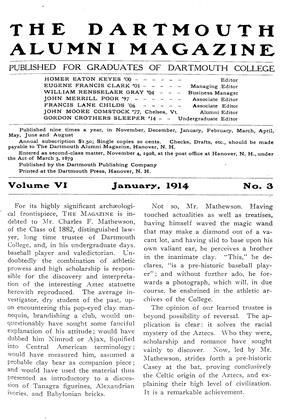During the three weeks preceding the Christmas holidays, the Department of Fine Arts has held three small exhibitions of etchings, which were popularly dubbed "print shows".
They were arranged in W Dartmouth and were open to the public daily, except Sunday, from 2 to 4. The first of these show's incLtded etchings by Joseph Pennell, Herman A. Webster, and Earl H. Reed. Mr. Reed, the Chicago artist, generously loaned an almost complete collection of his poetic interpretations of Chicago subjects and Lake Michigan dunes, including proofs from his latest plates. It was as representative a showing of his art as was to be found in his recent successful exhibition at the Brown-Robertson galleries in New York City.
Byway of contrast with the excellent work of this stay-at-home American, there were eight proofs of European subjects by Webster, and six prints of New York skyscrapers by Pennell.
1 he second print show was devoted to wood block prints by Bertha Lum and color-etchings by George Senseney, W. Lee Hankey, and T. F. Simon, who is probably the most popular etcher in color.
The third exhibition consisted of forty-two etchings by Thomas Wood Stevens and Helen B. Stevens, including their American college series of fifteen plates, and of a few prints of Gothic cathedrals by the French master Auguste Lapère.
These three shows were undertaken as an experiment, and the response on the part of the community was greater than had been expected. Both students and faculty came again and again, and many lingered to read the pamphlets and magazine articles relating to the artists. In view of this interest and the many words of enthusiastic approval, it has been decided to continue the print shows through the year as a regular feature of the work of the Department of Fine Arts.
From January to June, 1914, there will be similar exhibitions, not every week, but once a month. Etchings by American artists will be shown, as well as the best work of old and modern European masters of line, among whom are Frank Brangwyn, Anders Zorn, Sir Seymour Haden, Whistler and Millet. The purpose of the department is to give an idea of the originality, the delicacy and the intimate personal quality of the work now being done by the best American etchers and to compare it with that of the greatest European masters.
For the first semester of 1914-15 the department has announced a course on Engraving and Illustration which will deal with the great engravers and etchers from Dürer and Rembrandt to the masters, of the twentieth century, and will include a study of the present revival of etching. In this connection, the little print shows are not only giving pleasure to many now, but are preparing the way for a more general interest next year.
These exhibitions are made possible by the generosity of Albert Roullier of Chicago, and of Frederick Keppel and Co., of New York, who loan the College their precious prints without pecuniary reward. Mr. Earl Reed and Mr. and Mrs. Stevens have given generously of their time in preparing the groups of their etchings. Another artist who has promised the college a loan of his etchings, is Everett L. Warner well known also for his distinguished work in landscape painting.
 View Full Issue
View Full Issue
More From This Issue
-
 Article
ArticleMORE ABOUT DARTMOUTH SONGS
January 1914 -
 Class Notes
Class NotesLOCAL ASSOCIATIONS
January 1914 -
 Class Notes
Class NotesCLASS OF 1861
January 1914 -
 Class Notes
Class NotesCLASS OF 1864
January 1914 -
 Article
ArticleFor its highly significant archaeological frontispiece, THE MAGAZINE is indebted
January 1914 -
 Article
ArticleTHE OLCOTT-LEEDS HOUSE
January 1914 By Charles Frederick Bradley, '73








